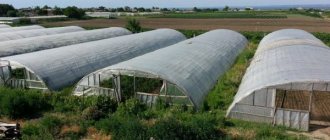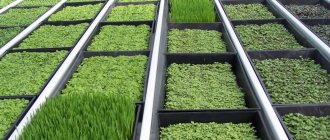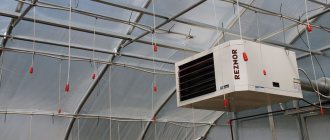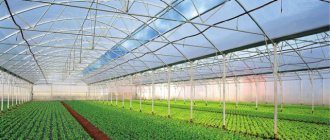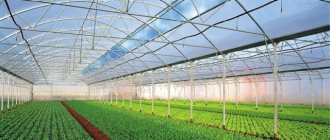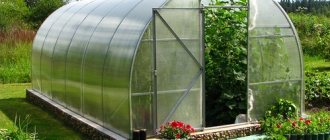03.03.2022 1,114 Business plans
Author: Emin
Country chores in a greenhouse or greenhouse can turn into your own business. To organize a profitable greenhouse business, you need to decide where to start and what crop is more profitable to grow for sale.
| Starting investments | 4,320,000 rubles | Staff | 3-6 people |
| Income monthly | 150,000 – 660,000 rubles | Competition | Average |
| Expenses monthly | 112,000 rubles | Payback | 3-36 months |
[Hide]
How much money is needed to organize a greenhouse farming
According to preliminary calculations for the opening of a greenhouse with an area of 2016 square meters. meters will require an investment of about 14 million rubles:
- Preparatory work, arrangement of the site - 700,000 rubles.
- Purchase, delivery and installation of greenhouse structures - RUB 5,000,000.
- Greenhouse equipment (irrigation system, heating, ventilation, etc.) - RUB 3,500,000.
- Purchase of other equipment and inventory (packaging machine, racks, buckets, boxes, etc.) - RUB 500,000.
- Costs for connecting utility networks (gas, water, electricity) - RUB 250,000.
- Construction of an administrative building and utility buildings. block - 1,500,000 rub.
- Purchase of planting material - 400,000 rubles.
- Purchase of a truck (for product sales) - RUB 700,000.
- Business registration, approvals and permits - RUB 150,000.
- Other expenses - RUB 300,000.
- Reserve fund - 1,000,000 rubles.
Correct choice of coating material
An important element of the greenhouse, which will have a significant impact on the volume of products produced, its quality and cost, is the material chosen for its covering.
| Material | Advantages | Flaws |
| Film | Ease of use, ease of installation, safety, low cost. | Low strength, vulnerability to wind, condensation, fragility. |
| Glass | High transparency, environmental friendliness, durability. | High cost, fragility, heavy weight. |
| Polycarbonate | Strength, light weight, transparency, good thermal insulation. | High price. |
Market prospects
Greenhouse business in Russia is considered a promising area. This is especially true in areas with harsh climatic conditions, which include most regions of the Russian Federation. This industry is of great importance, as it is designed to supply the country’s population with fresh vegetables and herbs, the demand for which has been steadily growing in recent years. Today people are ready to spend more and more money on vegetables and herbs than they did 15 - 20 years ago. The fashion for healthy eating forces people to allocate more and more funds from their budget to purchase products that are so important for the human body. The main problem hindering the development of the industry is high energy tariffs. Currently, the area under cover of vegetables in Russia is no more than 2,000 hectares. For comparison, in China the area of greenhouse farms is 1.7 million hectares. However, there is a green light in this direction. The state is increasingly paying attention to the development of the industry and is ready to help beginning and existing farmers by allocating land plots at preferential rates, subsidizing interest rates on loans and issuing grants for the development of greenhouse farming.
Video
Those who have already tried themselves in the greenhouse business give excellent reviews. Video channel sotka-spb. ru
Do you have any questions? Specialists and readers of the BiznesOK website will help you ask a question
Was this article helpful?
Thank you for your opinion!
The article was useful. Please share the information with your friends.
Yes
No
X
Please write what is wrong and leave recommendations on the article
Cancel reply
Rate the benefit of the article: Rate the author
Discuss the article:
Product Description
Our farm will be engaged in the production of vegetable crops - cucumbers and tomatoes. The productivity according to the preliminary plan will be 90 kg/m2 (per year). Annual production volume with an area of 2016 sq. meters will thus amount to 181,440 kilograms of fresh vegetables. The average annual wholesale price per kilogram of products will be 65 rubles. The main clients of the farm: wholesale resellers, processing plants and retail chains. The planned annual turnover of the enterprise, after the sale of all manufactured products, will be about 11,500,000 rubles.
Download a greenhouse business plan from our partners, with a quality guarantee.
Features of consumer search
The establishment of distribution channels begins from the moment the greenhouses are erected or long before that. This way you can avoid downtime and guarantee stable profits throughout the year. Vegetables have a short shelf life, so it is recommended to find 2-3 options at a time.
Wholesale bases
The less ripe vegetables are stored in greenhouse warehouses, the greater their chances of being sold. Otherwise, the price falls, and you have to worry about delivering the products to the sales points. Delivering goods to a wholesale base is the most profitable way to achieve 100% sales of vegetables.
Wholesale base
Resellers
Their priority is to have their own transport. You do not have to waste time and money on delivery of goods. The only negative is that some of them significantly reduce the price. Therefore, it is better to deal with several resellers so that you have a choice.
Processing plants
Regular emphasis on the production of canned products requires a continuous supply of new raw materials. The benefit of cooperation with processing enterprises is that they can be supplied in large quantities at reasonable prices.
Retail Stores
This option is more difficult, but it is worth the effort to establish contacts with the owners and their representatives. Here you will have to take their recommendations into account. Delivery is carried out at the expense of the farmer.
Retail outlet
Cafes and restaurants
This requires the ability to build trusting relationships with people. But your advantage is that you can supply exotic products to restaurant establishments, the cost of which is higher than traditional crops.
Exotic vegetables for supply to a restaurant
What equipment to choose for greenhouse farming
As equipment, it is planned to purchase industrial polycarbonate greenhouses for growing agricultural crops “Farmer”. The design of this greenhouse is designed in accordance with SNiP 2.10.04-85. During the construction of the Farmer greenhouse, modern thermal insulation materials are used to reduce heating costs, making it possible to operate it all year round.
The frame of the greenhouse is made of a powerful galvanized profile and consists of arc-shaped trusses connected to each other by purlins. The width of the greenhouse will be 7.5 m, height 3 m, length 67.2 m. The area of the greenhouse will be 504 sq. m. m. The greenhouse will be installed on the ground with the foundation posts buried. In total, it is planned to purchase four similar greenhouses. Thus, the total area of the farm will be 2016 square meters. In addition to the greenhouse design, it is planned to purchase and install gas boilers (for heating), household appliances. block, a packaging plant, an administrative building for staff accommodation and a shower room. As for the greenhouse equipment itself, the following components will be purchased: an installation for drip irrigation of plants, a fertilizing system, a ventilation system, as well as additional equipment and inventory (racks, buckets, boxes, etc.).
Greenhouse business from scratch: choosing what to grow
Owners of greenhouse farms with experience practice changing crops in the greenhouse. Starting a greenhouse business from scratch, you can grow berries in the summer, flowers and seedlings in the spring, and herbs and vegetables in the autumn-winter period. This approach makes it possible to receive constant profits.
If you are just trying your hand as a farmer, start small - study the specifics of the main directions and choose the appropriate option.
Seedling
Seedlings are an interesting and at the same time complex direction. The disadvantage is a large number of competitors. On the plus side, with proper quality, you will always have regular customers.
The main condition for success is healthy seeds. Your task is to grow strong seedlings from them, divide them into individual plants and replant them. Young shoots require warm conditions and an additional source of lighting.
Poor quality soil can destroy plants. Just soil from the garden will not work: microorganisms settle in the greenhouse with it. Purchasing store-bought soil will also not give the expected result. Each crop needs a specific soil mixture.
Greenery
A business growing greens is an ideal solution for those who do not yet have practical experience working with a greenhouse. Green onions, parsley, dill, basil - these plants do not require care, are inexpensive, and are constantly in demand.
All that needs to be ensured for a normal crop harvest is the optimal temperature: not lower than 18 degrees, as well as additional lighting.
Forcing greenery does not require a large amount of free space - it is grown along the entire perimeter of the structure: along, across, in height, in special racks. With good care, one cutting yields 2.5 kg of fresh herbs.
Vegetables
If you decide to get into vegetables, study the demand for them in your region. Keep in mind that no more than two crops are grown in one greenhouse - for example, tomatoes and cucumbers. The main condition is to create territorial boundaries and provide different conditions of detention.
Experts recommend that novice businessmen practice planting radishes and Chinese cabbage. These crops rarely get sick, are stored for a long time and are easy to care for.
Note! Note! The record holders for growth are cucumbers and zucchini - 8-9 weeks pass from sowing to harvest. At the same time, they require a large area and are capricious in maintenance. The same applies to most varieties of tomatoes and sweet peppers. Their price is an order of magnitude higher, but the growing cycle is longer. The maximum you can receive is two fees per year.
The main difficulty in growing vegetables is temperature. They grow well in warm conditions - no lower than 25-30 degrees. In regions with harsh winters, it is extremely difficult to provide such a temperature background in a greenhouse.
Advice! When choosing a tomato variety, give preference to small-growing varieties - such tomatoes are more readily purchased. They are good both for use in salads and for canning.
Flowers
The flower business is one of the most profitable. Flowers grow well indoors and are not afraid of cold weather. The main thing is to choose the right bulbs. Sometimes they are affected by scab. In addition, there is a risk of buying for the grade that the seller shows. Instead of bulbs of elite varieties, they can slip in standard types that cost several times less.
Note! The greatest profit can be obtained if you calculate the ripening of flowers by specific days - for example, September 1, March 8.
The most important stage in growing plants is preparing them for transplanting into a greenhouse. There are certain difficulties with storage and sale: here the days count. If you do not realize the collection on time, you can suffer significant losses.
Advice! If you want to stand out from your competitors, don’t be afraid to experiment. Play with the composition of the soil, lighting - and get interesting color shades. Flowers of unusual colors always sell better.
Step-by-step plan for opening a greenhouse farm
The list of works for organizing an enterprise is as follows:
- Business registration, approvals and preparation of documents
- Concluding a land lease agreement
- Preparation of the land plot
- Summing up communications
- Purchase of a greenhouse, delivery, installation of the structure
- Roofing
- Finishing work
- Electric installation work
- Installation of ventilation systems, irrigation, plumbing work
- Installation of equipment, shelving
- Landscaping
- Installation of household block, household structures
- Hiring workers
- Conclusion of contracts (solid waste removal, disinfection, etc.)
- Purchase of planting material
- Starting a business
How to obtain documents for growing vegetables
If the land plot for the construction of greenhouses is your property and you do not plan to work on a large scale, hire additional workers and sell finished products to legal entities, then no special documents are required to organize such a subsidiary farm. To sell the harvest, it will be enough to take a certificate stating that the land on which the greenhouses are located belongs to you.
If you are going to attract additional labor, organize larger production and sell your products through stores, retail chains, and also supply them to catering establishments, you will have to register as an individual entrepreneur or organize a private agricultural enterprise. In the latter case, you will be entitled to certain tax benefits, but keep in mind that in practice many of them will not be so easy to achieve.
State registration of peasant farms (peasant farms) is carried out in the same manner as was established for state registration of individuals as individual entrepreneurs. In this case, only the farm manager is registered. To do this, he must submit the following documents to the registration authority:
- application for registration (form established by law);
- agreement on the creation of a peasant (farm) enterprise (if there is a need for it);
- a copy of the main identification document of the head of the farm (passport);
- document confirming payment of state duty (original);
- copies of documents confirming the relationship/property of members of the peasant farm.
Please note: an application for transition to a special tax regime (USN or tax for agricultural producers) is submitted simultaneously when submitting documents for registration of a farm. Then the selected mode can be applied from the moment of registration of the peasant farm.
A farm is registered by the authorized body at the place of permanent registration (registration) of the head of the farm. Its deadline is on average five working days from the date of submission of documents. As a result, you will receive a Certificate of state registration of the head of a peasant farm, a Certificate of registration with the territorial tax authority, an extract from the Unified State Register of Individual Entrepreneurs and an information letter from the State Statistics Committee with OKVED codes.
If a farm is organized not by one person, but by several, then an agreement must be concluded between all participants, which provides the following information:
- about members of the farm;
- on the recognition of one of the members of this farm as the head of the farm, the powers of the head of the farm and the procedure for managing the farm;
- on the rights and responsibilities of members of a farm;
- on the procedure for the formation of farm property, the procedure for owning, using, and disposing of this property;
- on the procedure for becoming a member of a farm and the procedure for leaving a member of a farm;
- on the procedure for distributing fruits, products and income received from farming activities.
The list of this information can be expanded. The agreement is accompanied by copies of documents confirming the relationship of the citizens who decided to create a joint farming enterprise. In addition, the agreement is signed by all members of the farm.
Financial plan
Fixed monthly expenses (average from September to May)
- Rent — 25,000 rub.
- Salary + insurance contributions - 370,000 rubles.
- Fertilizers, protective equipment - 20,000 rubles.
- Heating — 66,000 rub. (33 rub./sq. m.)
- Electricity - 20,000 rubles. (10 rub./sq. m.)
- Water supply - 4,000 rubles. (2 rub./sq. m.)
- Packaging — 25,000 rub.
- Depreciation of equipment - 10,000 rubles.
- Seeds - 7,000 rubles.
- Fuel and lubricants - 40,000 rubles.
- Other expenses - 20,000 rubles.
Total - 607,000 rubles. The annual expenses of the farm will be 7,284,000 rubles.
Organizational structure
Staffing:
- manager - 1,
- farmer - 3.
The total number of employees is 4 people.
The success of the project depends on the well-coordinated work of the team. The key person in this matter is the manager. At the start, this can be the business owner himself. The main responsibilities are coordinating activities, providing distribution channels with high-quality and fresh products.
As an owner, you will need to study and constantly be interested in the intricacies of this matter. For permanent work, you should hire 3 farmers with a shift work schedule.
Key qualities that employees must have:
- ability to work,
- honesty,
- decency,
- responsibility,
- attentiveness,
- neatness,
- experience in this field.
The wage fund is presented in the following table (RUB):
| Amount of workers | Cover part | Salary amount | |
| Manager | 1 | 40 000 | 40 000 |
| Farmer | 3 | 25 000 | 75 000 |
| Total: | 115 000 |
A detailed calculation of the payroll, taking into account insurance premiums, is presented in the financial model.
How much can you earn from greenhouse farming?
Net profit at the end of the year of operation of the farm will be 3,963,040 rubles (330,253 rubles per month). It is worth noting that such results can only be achieved subject to 100% sales of all manufactured products. The profitability of the organization according to business plan calculations will be 54%. With such indicators, the return on investment in the business will occur in 42 months or 3.5 years.
We recommend downloading a greenhouse business plan from our partners, with a quality guarantee. This is a full-fledged, ready-made project that you will not find in the public domain. Contents of the business plan: 1. Confidentiality 2. Summary 3. Stages of project implementation 4. Characteristics of the object 5. Marketing plan 6. Technical and economic data of the equipment 7. Financial plan 8. Risk assessment 9. Financial and economic justification of investments 10. Conclusions
Risks and payback
Possible risks that an entrepreneur may encounter are presented in the table.
| Risk name | Probability of occurrence | Mitigation measures |
| Poor quality seeds | High | Careful selection of suppliers |
| Plant diseases and pests | Average. | Consultation with an experienced agronomist-vegetable grower |
| Utility accidents | Average | Availability of alternative sources of water and electricity supply |
Approximate payback.
| Culture | Payback period |
| Vegetables | 2-3 years |
| Greenery | 3 months |
Which OKVED code to indicate when registering a business?
To register a business, you will need to indicate the necessary codes from OKVED-2, Section A: Agriculture, forestry, fishing and fish farming:
- 01 Crop and livestock farming, hunting and provision of related services in these areas.
- 01.1 Growing annual crops.
- 01.13 Growing vegetables, melons, root and tuber crops, mushrooms and truffles.
- 01.13.1 Growing vegetables.
- 01.13.12 Growing vegetables in protected soil.
Do I need permission to open?
If you do not plan to sell the crops you grow in stores and hire staff to care for them, then no permits will be required. In the case of sales of products to legal entities, it is necessary to register an individual entrepreneur or peasant farm. The quality of growing conditions and goods for sale will be controlled by the relevant sanitary and epidemiological authorities. When installing heating equipment, you will need permission from the fire safety inspectorate. A businessman may need contracts for fertilizing the land, treating pests, dry cleaning clothes, etc.
Beneficial insects for greenhouses
Bioagents are the scientific name for beneficial insects that are responsible for the number of pests in a greenhouse. They are used as soon as the first signs indicating the presence of pests appear. How it works? Beneficial insects that enter the greenhouse look for food for growth and reproduction. By eating harmful microorganisms, they intensively increase their numbers and, accordingly, reduce the “enemy army”.
The most harmful inhabitants of greenhouses are spider mites and whiteflies. These pests reach their maximum concentration during harvest periods, which makes it difficult to use chemical means to combat them. Encarsia copes with whiteflies, Phytoseiulus defeats mites. Ready-made colonies of beneficial insects can be purchased at agricultural stores.
